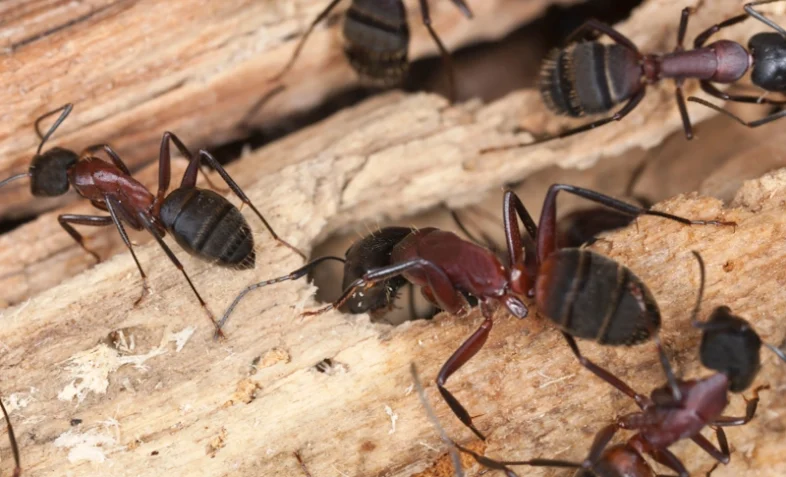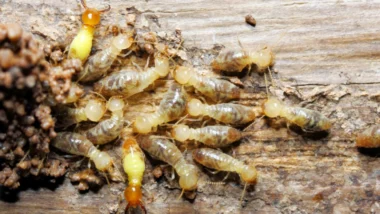Podcast: Play in new window | Download
Hello, I’m Will White with Nexus pest solutions. And today I want to talk about carpenter ants. You know, every year, in Wisconsin, we enter into what has been deemed as carpenter ant season, which is the end of April, May, June, depending on when our spring starts around here, I was casting because you know, sometimes spring doesn’t start until July.
But regardless, and without fail, we’re going to have our carpenter ants waking up out of dormancy, and going absolutely nuts around a house where we’ll get the calls the frantic calls every single year, you know, you open up the dishwasher, there’s ants in the dishwasher, you open up the cabinets, there’s ants in the cabinets, there’s ants, ants, ants.
Now these things are looking for food source to get that brood, that brood going, you know, at the colony, and folks always ask, Where did they come from? You know, where did these ants come from? You know, we don’t have any leaks in our home, you know, what is going on?
Well, you know, one of the big things I can say is 99% of the time, the carpenter ant the original carpenter ant colony is outside more than likely an old mature tree. Now it’s like, well, that tree could be in your yard, or it could be in a neighbor’s yard, or could be two yards over. Who knows. Because, you know, carpenter ant workers, okay. And these are numbers of keep that keep in mind, you’re only seeing 10 to 15% of the population.
And actual colony of carpenter ants can have anywhere from 10 to 15,000 ants in the colony. And that you’d never really get to see what you’re seeing in your place. And around your house is the workers. So this forger, this worker to 10 to 15% that you’re seeing can forge you know, 200, you know, two football fields, up to three football fields away from the actual nest, foraging for food. So is something about because it’s not every house on the block? I mean, keep that in mind, not every house on the block is having a problem with these ants. But it’s something about your house that might have some conducive conditions that make it more attractive to the ants.
So what can you do you know, what is one thing you can do to try to make your exterior a little bit less attractive, you know, whether you have a leak or do not have a leak, you know, on that knowing one, one of the easy things that you could fix right away is to trim the shrubbery and bushes off the home, you don’t want anything touching the home.
Another thing if you have a tree with a branch overhanging and touching the roof, you want to trim that branch off of the roof, because those in the ant world are like bridges, they offer easy access to your home. And another thing about that is it causes the ant population to bypass any treatment that you’ve done. Because if they walk up to tree, walk across a branch, all your treatment is down low. They bypass it all together. So by you removing those bridges, it forces the ants to walk up the side of the house to get to where it needs to go. Therefore walking through your treated area. So some folks are going to be do it yourselfers, you know, that’s a pro tip. You know, that’s a pro tip right there.
And then you have other folks who might want to call someone or like what can I do try to prevent this, you know, we get this problem every single year. You know, you can start out by trying that. And remember, if all else fails, you can call it Nexus Pest Solutions.
Now, what I’m about to show you is something that we removed from a house north of north of Milwaukee. A couple years ago, we had a client call us up because they were having an issue with carpenter ants it was seeing winged large wing carpenter ants. Now. There’s a story here. So you can have carpenter ants. But if you start to see winged, you know, ants, when people say flying ants, flying carpenter ants, they don’t fly, they develop wings. You know, they might use those wings or break a fall if they fall off something but they’re not known for flying around, like bees or wasps or anything like that. But what that story is, if you see this is telling you that, that nest is a mature nest and he has been there at a minimum of two to four years, could be longer. And, you know, once once a colony has established itself and matured, the ants will develop wings and it just takes a period of time for that.
I know it’s usually somewhere between four to six years, but it just means that they’ve been there a minimum of two to four years, you know, because there could have been circumstances outside that caused them to move there. So not necessarily that they’ve been in your house for that amount of time, it could have been unforeseen circumstances outside that cause a mature nest to move.
And, you know, one other thing is I said earlier, these ants are foraging, you know, two to three, up to two to three football fields from origin. So just because you’re financing your house doesn’t necessarily mean that you have activity, you know, you have a colony in your house. And if you did, that would be considered a sub colony, or a satellite colony, and some people do. So if the conditions are favorable. That nest, that original next produces a queen, she’s going to have to move they’re going to evict her. So she’s going to pick up and move so many workers with her and start a satellite colony. And a lot of times, that’s how we end up with them in our homes.
So, but back to my story. So we we went to this location, he says North of Milwaukee is one of suburbs, suburbs north of Milwaukee. And this client was having a major issue. He was any flying ants. So we went out there. And we started doing some treatment, you know, we started doing some treatment, trying to figure out where this thing was going on. And all of a sudden, we start fleshing out these big ants. So this guy, you know, this individual, he wanted to get down to the nitty gritty, once we found out he wanted to see exactly what was going on. So he actually removed the drywall, and gave us all the exposure we need. We ended up cleaning the ants out and this is what we found. See this right here, I kept this this is this is two years old. So you can see, hopefully, this cameras really picking that up. But this here, you know, this, this here kind of shows you.
One of the things that we hear a lot that carpenter ants do not next in solid wood. Let me just show you this. Again, they do not nest and solid whatnot. If you look at that. This is a solid piece of wood. And what happened here. The nest was nesting. It originated in softwood so he did have a leak inside the wall. But as at nest because remember what I’m saying the nest started to expand. Well, the ants ended up excavating out the solid wood to create room for the expanded nest because remember, they were winged ants that we saw. So they said that they’ve been here, two to four years ago, they weren’t sitting still, that nest was populating, and it was growing. And so they needed more room. So they started excavating hardwood.
Here’s another pro tip. So one of the first pro tip was he was in pause right there for a minute. The first pro tip was, we want to clean you know, like make sure nothing is touching the house. All the way around. Now, some folks are looking at this. And they’re saying, hopefully I get a good picture at some folks are looking at this is like, Well, how do you know that had carpenter and activity and not termite activity? Well, here’s the difference. So if you’re out there, you’re remodeling a home, and remodelers come across something like this inside of a wall. Well, the quickest way to determine if it’s termite damage, or carpenter ant damage here, if you look inside of those spaces, the wood is clean. See that? It’s clean carpenter, it’s a very meticulous, so when when we talk about the wood piles, you know, customers call them, Hey, I have wood piles on my countertop, I got wood piles by my door, that’s what’s happening. They’re excavating the wood, and they’re dropping, you’re cleaning that wood out and they’re dumping that saw dust, which in our world is called frass. They’re dumping their sawdust, which is create a pile well with termites, this type of damage the galleries, which these are called galleries, those openings you see in there, you’ll find soil and mud inside the gallery. So these galleries carpenter and galleries are clean, termite galleries will have debris out, soil, mud, you know something of that nature, it won’t be cleaned, but if it’s clean on the inside, first sign that is carpenter ant damage. So this client likes a cut this out of his wall, and it’s a proven fact that these guys will nest in solid wood.
So if you have a carpenter ant problem, or if you simply have a question, feel free to give us a call at Nexus Pest Solutions 414-355-3732 we’ll be happy to assist you any way we can. And once again, thank you for watching this video and I hope you have a great day.
Transcribed by https://otter.ai

